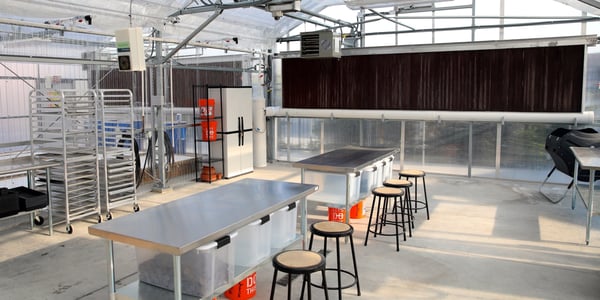What if your product is… learning? What if your mission… is to produce prepared students? What if the beauty of ‘abundance’ includes plants... but is not limited to plants?...We saw what abundance looks like, and we saw it possible for every Faith student. The Faith community agreed.

“WHATEVER YOU DO, DO NOT DESIGN YOUR GREENHOUSE AROUND LEARNING! DESIGN IT AROUND SALES...”
This was the correction given to us from several commercial growers during the design phase of our research greenhouse. Industry took eye-rolling exception to the variety of complicated, space inefficient systems we were integrating in place of the accepted practice of mass production of a single crop. If money is the definition of success, then automated, people-less efficiency is a winning formula. When productivity is measured in square feet of product: volume silences variety, manuals overwrite conversation and people are a waste of space. A couple laborers put the seed in the soil, set the sprinklers to auto, come back in 60 days, put it on a pallet jack for a volume order, and repeats. This ‘hands-off’ approach is a profitable way to turn out a lot of product with minimal overhead. So, when industry gives educational advice, they default to these indisputably proven and highly effective business principles.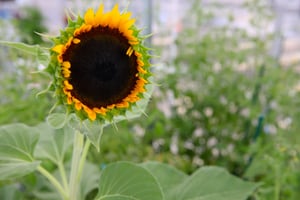 For educators, unlike industry, our raw materials are not given to us as factory-stamped widgets. Students walk, bounce and shuffle through our doors ‘as is’; each a unique heirloom variety. If industry’s business model of Henry Ford efficiency became education’s attitude toward students, funds would be retooled exclusively toward a select group of elite students, athletes, and performers. The facility’s budget would be pruned of colorful classroom bulletin boards, beauty and blue skies for a better bottom line in an Orwellian dystopia. Educators’ lives may be simpler, but it would be hardly effective for ‘EVERYONE prepared! EVERYONE saved!’
For educators, unlike industry, our raw materials are not given to us as factory-stamped widgets. Students walk, bounce and shuffle through our doors ‘as is’; each a unique heirloom variety. If industry’s business model of Henry Ford efficiency became education’s attitude toward students, funds would be retooled exclusively toward a select group of elite students, athletes, and performers. The facility’s budget would be pruned of colorful classroom bulletin boards, beauty and blue skies for a better bottom line in an Orwellian dystopia. Educators’ lives may be simpler, but it would be hardly effective for ‘EVERYONE prepared! EVERYONE saved!’
But what the pros forget, parents remember. What if your product is… learning? What if your mission… is to produce prepared students? What if the beauty of ‘abundance’ includes plants... but is not limited to plants? So, when our student-faculty design team toured the mind-blowing hydroponic, aquaponic, and soil facilities at the University of Arizona, Tucson and area high schools, we all resounded, “That was awesome! Let’s do that. ALL of it.” We saw what abundance looks like, and we saw it possible for every Faith student. The Faith community agreed.
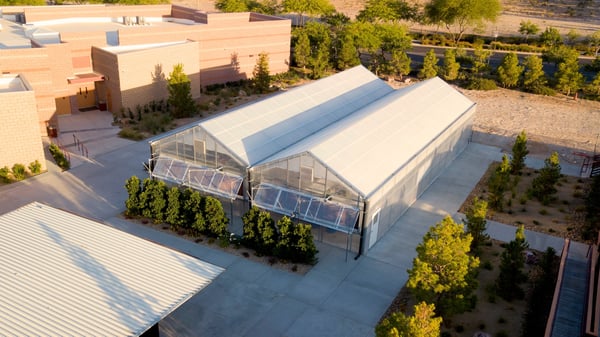
So let’s take a look at what a ‘hands on’ and ‘minds on’ research greenhouse looks like...
The Williams Research Greenhouse is a state-of-the-art, 3200 square foot, soil and soil-less crop facility designed for 6-12 grade use in our science classes, special ed program, foods class, academies, and clubs. The students develop, build, grow, problem solve and share their projects and produce with each other and the community.
Two Independant Environments: 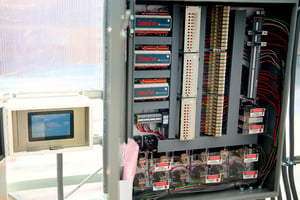
Sensors trigger all the built-in features of the two adjacent houses, including a system of fans, pad walls, and retractable, reflective shade cloths.
Food for Thought: The house itself is a teachable moment: Graph the weekly outdoor temperatures against the pad wall water consumption.
Quadrant 1: Multi-Purpose Area
In the first quadrant, we have a multipurpose work area with tables and racks for potting, transplanting, and harvesting. STEM Academy students and the Greenhouse classes will use this area to house the projects they engineer.
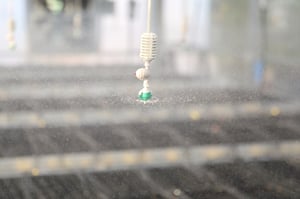 Quadrant 2: Six Rolling Tabletop Benches
Quadrant 2: Six Rolling Tabletop Benches
With each table at 4’ x 16’, we have 384 square feet of table surface for our potted plants to grow. This can hold over 1,000 6” pots. These tables are fitted with overhead sprinklers, mounted aqua turret drippers, or can be hand-watered at the turn of a valve.
Food for Thought: We teach plant biology, horticulture practices, and collect measurements on soil moisture, plant height, stem thickness, fruit size, quantity, and mass.
Quadrant 3: Hydroponics, Three Raft Systems 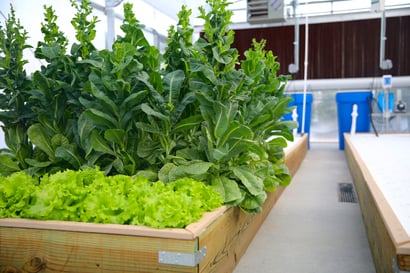
Here we will grow 240 square feet of hydroponic lettuce and other lightweight greens. This is made of three 4’x20’ raised garden beds. Except, instead of soil, you will notice that they have a liner that is full of water with Styrofoam boards floating on top.
Lettuce grows from 1.5” square cutouts, for up to 420 lettuce plants and herbs at a time. If you look underneath the Styrofoam you see a fibrous tangle of roots. Water cycles from a large blue can (sump) at the far end of these rafts through an underwater pipe. We have air stones oxygenating the water and all our chemical additions take place in the sumps as well.
Food for Thought: The level of control available with hydroponics is absolute. Unlike soil, in hydroponics you know with precision the exact chemicals and quantities the plants are receiving. The instant you input, they immediately uptake, and you can measure the outputs with chemical titrations, plant mass, or simply tasting the plant.
Quadrant 4: Hydroponics & Aquaponics
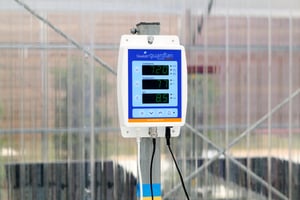
Heading into the next house we have all the hydroponic and aquaponic systems. The water and fertilizer requirements are low, as there is no leaching or runoff for the water and fertilizer and very minimal evaporation. The main thing about hydroponics is to keep the water oxygenated, chemically balanced, and moving. We have remote sensors at each system reporting the water temperature, pH, and electroconductivity to measure fertilizer quantities.
Three Hydroponic Tower Gardens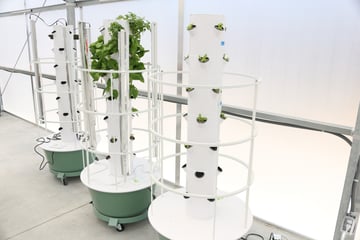
We have three tower gardens with the ability to grow a total of 84 plants up the center towers. You put your herbs, lettuce, strawberries, etc. in these tall cylinders and water from the sump sprays all over the roots within.
Food for Thought: Join any Facebook hydroponic group and you will quickly learn that there is no “one” way to do hydroponics. Tinkerers around the globe follow a few basic principles, and the rest is up for grabs and debate. Our greenhouse classes will be tinkering themselves and discovering science, engineering and art in the process.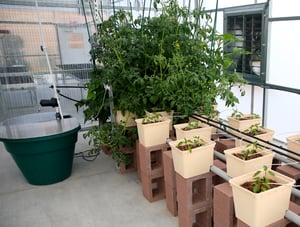 Two Bato Buckets Systems
Two Bato Buckets Systems
These are a series of 24 daisy-chained buckets and 10 in another system for a total 34 square feet of growing area. The buckets are filled with inert marble sized clay pebbles for root anchoring.
You add the fertilizer to a large sump that recycles the water through a drip system. In one system we will have “indeterminate” tomatoes that will grow 10’ up to the ceiling with a moving trellising system. When the vines reach the ceiling, students will slide the top half of the plant along the overhead cable.
Food for Thought: Can you really grow anything hydroponically? What about a potato or a carrot? Let’s let our eleven year olds try…
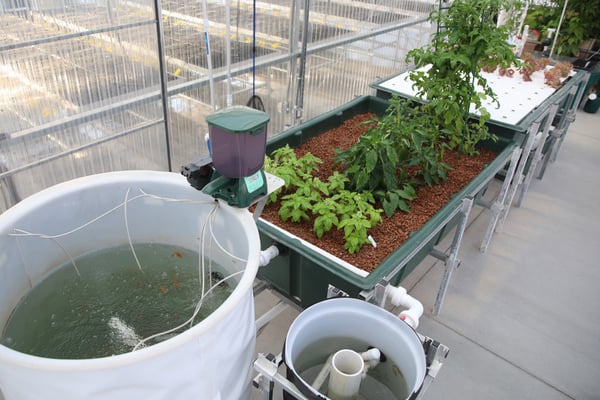
Aquaponics System
“Aquaponics” is a cross between “Aquaculture” (growing fish) and “Hydroponics” (plants in water). This whole system has a wide variety of buffers and fail-safes to keep the system from going into ‘catastrophic collapse’ if a leak occurs at most any point.
Our system has 56 square feet of growing space and holds a total of 650 gallons of water. It all begins at a large tank that currently house our shubunkins and goldfish. The only chemical input to this system is fish food. The solid waste is gravity separated and eliminated in an adjacent tank. The liquid ammonia is broken down by a variety of bacteria into nitrates for the plants. The clean water is recycled back to the fish.
Food for Thought: Hydroponics is popular in communities with poor soil, homes with limited space, high end restaurants, niche commercial crops and with NASA’s lunar program. Yet, the professional observation stands, “No serious farmer would ever grow crops using fish.” Other than how our entire planet runs on a balance between plants, animals and bacteria, they are correct. Aquaponics is a hands-on way to learn cycles: the nitrogen cycle, carbon cycle, water cycle, and food web. There is an observable chemical relationship between the fish, bacteria, and plants that must be in balance for all to remain healthy. This is an excellent ecology lesson and miniature of how this tiny spaceship Earth of ours works.
Being exceptional means others will take exception...
We are excited for our students to develop their passions for biology, ecology, chemistry, engineering, economics, the scientific method and community service. For students who wish to learn the best practices and economics of a commercial greenhouse, we have a robust STEM Academy and Business & Entrepreneurship Academy where greenhouse and plant nursery internships will absolutely prepare them for the next level. They will learn industry’s invaluable lesson of how automated efficiency is indispensable to a sustainable business model and a well-fed planet. Research or commercial greenhouse aside... our students will be making a lot of lettuce.
Food for Thought: When ‘exceeding expectations’ is your school’s mantra, being the ‘exception’ must be the standard in producing exceptional students. With this product in mind, this is our research greenhouse’s “Thought for Food.”
Stay tuned for an article on donor appreciation, construction photos, ribbon cutting and for what all this produce will be used:
Facebook: FLHSGreenhouse
Twitter: @faithgreenhouse
Instagram: faithgreenhouse

